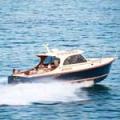Charles Sampson Carved a Legacy in Bath
Images courtesy Maine Maritime Museum, unless otherwise noted
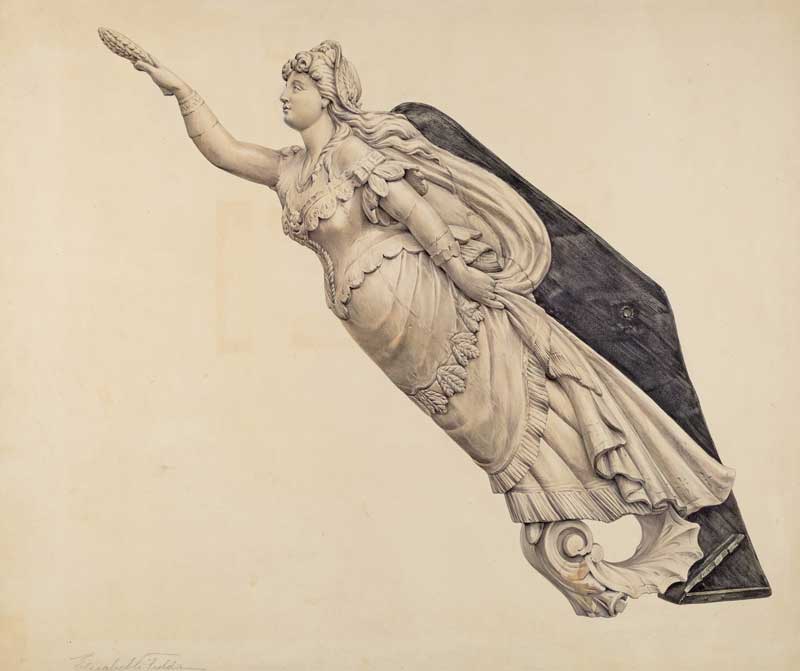 Watercolor of the Belle of Oregon figurehead was painted by Elizabeth Fulda in 1939 for the Index of American Design archives.
Watercolor of the Belle of Oregon figurehead was painted by Elizabeth Fulda in 1939 for the Index of American Design archives.
“Bath, in years past, has won for herself a reputation as a shipbuilding port, which has become world-wide; indeed, it has been said, Bath builds the ships of the world,” proudly declared the Daily Sentinel and Tribune on July 26, 1867.
Throughout the 1800s, Bath’s many shipyards—not to mention those in nearby towns—attracted hundreds of craftsmen with skills that ranged from metal and canvas work to carpentry and rigging. Among the many artisans, the work of the wood carvers stood out in particular, since beginning in the first decade of the 19th century, shipbuilders embellished the bows of their vessels with carved figureheads that reflected each ship’s character.
 The figurehead of the Belle of Bath by Charles Sampson, 1877, was recorded in a period photograph by J.C. Higgins of Bath.
In 1820 Nathan L. Winsor of Duxbury, Massachusetts, became Bath’s first full-time figurehead carver. By 1831, Bath native Freeman H. Morse entered the trade.
The figurehead of the Belle of Bath by Charles Sampson, 1877, was recorded in a period photograph by J.C. Higgins of Bath.
In 1820 Nathan L. Winsor of Duxbury, Massachusetts, became Bath’s first full-time figurehead carver. By 1831, Bath native Freeman H. Morse entered the trade.
Thirty one years later, G.B. McLain established a figurehead carving shop in the city. McLain came from Massachusetts, and brought Charles A.L. Sampson of Boston to work with him. While McLain was active in Bath during the 1850s, Sampson remained there for the rest of his life, becoming the city’s leading figurehead carver.
Charles Augustus Ludlow Sampson was born in Boston in 1824, the third child of Amos and Ann Matilda Smith Sampson. Sampson’s father was a Boston printer, who founded the Franklin Typographical Society. On July 31, 1852, Bath’s Weekly Mirror directed its readers to the advertisement of C.A.L. Sampson, ship carver, whom it described as “an excellent workman and a young gentleman worthy of confidence and patronage.”
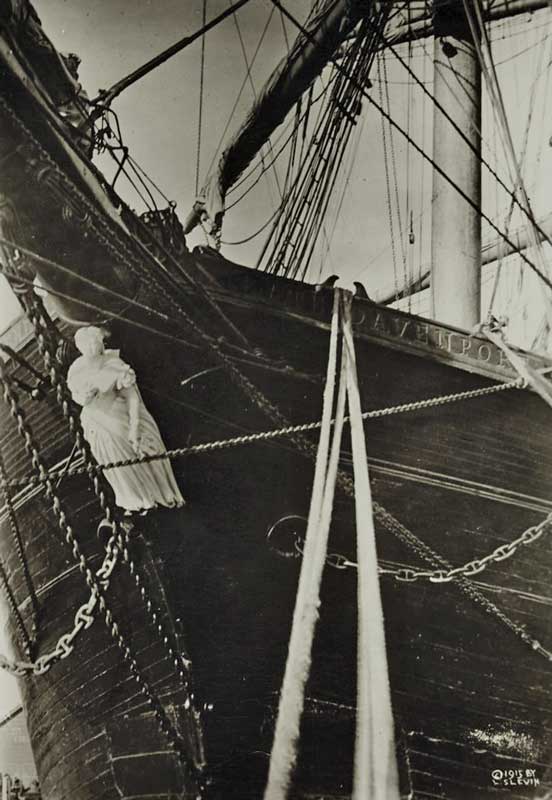 The figurehead of the Kate Davenport was carved by Charles Sampson and Cyrus Ingalls in 1866.
Sampson’s reputation as a talented craftsman soon earned him commissions for the figureheads of Bath-built ships. In 1853 he carved a Scandinavian warrior for the bow of the Viking. He followed in 1854 with a full-length figurehead of a young woman for the Emily St. Pierre. The next year he created a full-length figurehead of Captain Adam Lemont for his vessel of the same name.
The figurehead of the Kate Davenport was carved by Charles Sampson and Cyrus Ingalls in 1866.
Sampson’s reputation as a talented craftsman soon earned him commissions for the figureheads of Bath-built ships. In 1853 he carved a Scandinavian warrior for the bow of the Viking. He followed in 1854 with a full-length figurehead of a young woman for the Emily St. Pierre. The next year he created a full-length figurehead of Captain Adam Lemont for his vessel of the same name.
Sampson married Sarah Smith in 1855. He continued his trade as a ship carver until the outbreak of the Civil War. On April 29, 1861, Sampson enlisted in the Third Maine Infantry Regiment, where he served as captain of Company D. After training in Augusta, the regiment reported for duty in Virginia and fought in the First Battle of Bull Run on July 21, 1861. Sampson’s effective leadership of his company was rewarded with promotions to the ranks of major and lieutenant colonel.
Between April and July, 1862, the Third Maine saw action in five battles of the Peninsula Campaign in Virginia. During this period, Sampson became seriously ill in the Chickahominy Swamp, resulting in his resignation from the army on July 7, 1862. He returned to Bath to recuperate, accompanied by Sarah, who had been serving as a nurse with the Third Maine. As soon as Charles had sufficiently recovered, Sarah resumed her nursing duties on the battlefront and in Washington, D.C., military hospitals, serving until the war’s end. Her selfless devotion to the welfare of soldiers from her state earned her the title of “The Florence Nightingale of Maine.”
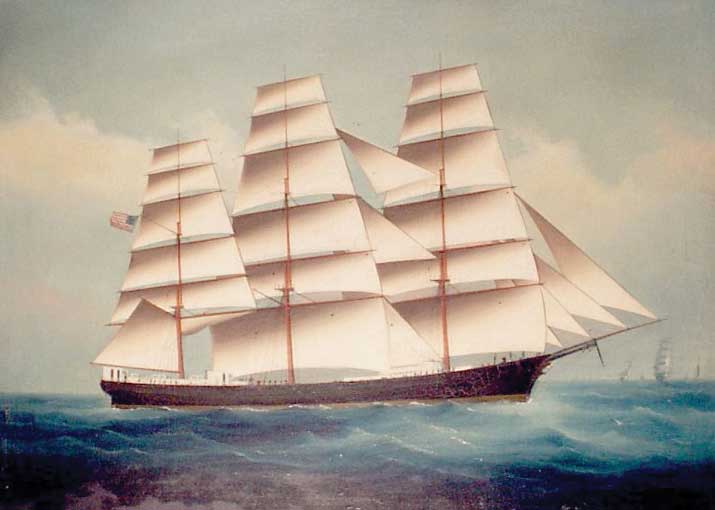 The George Skolfield, with its Sampson figurehead, was launched in Brunswick in 1870.
Between 1866 and 1880, Sampson made figureheads for 23 ships built in Bath, Brunswick, Phippsburg, and Richmond. Our knowledge of Sampson’s carvings comes from period newspaper accounts of the construction and launch of these vessels. Each article contains a reference to Sampson carving the figurehead. Many press accounts include detailed descriptions of his work and praise for his skill as an artist and craftsman. These articles reflect the importance accorded to figureheads and the pride that Bath took in having such a gifted carver.
The George Skolfield, with its Sampson figurehead, was launched in Brunswick in 1870.
Between 1866 and 1880, Sampson made figureheads for 23 ships built in Bath, Brunswick, Phippsburg, and Richmond. Our knowledge of Sampson’s carvings comes from period newspaper accounts of the construction and launch of these vessels. Each article contains a reference to Sampson carving the figurehead. Many press accounts include detailed descriptions of his work and praise for his skill as an artist and craftsman. These articles reflect the importance accorded to figureheads and the pride that Bath took in having such a gifted carver.
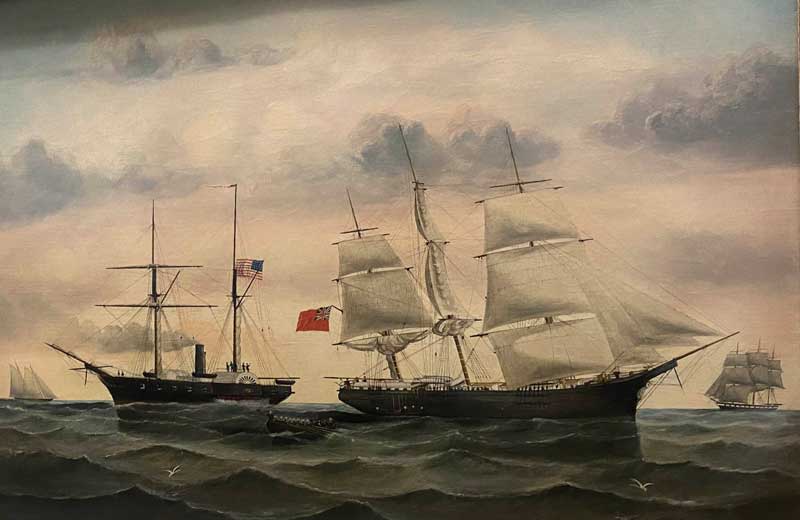 A 1862 Painting by William Gay Yorke in the Maine Maritime Museum’s collections shows the Bath-built and Charleston-based blockade runner Emily St. Pierre flying a British ensign, either because the ship was transferred to British registry for safety reasons during the Civil War or because it was flying the flag as a ruse when captured by the U.S.S. James Adger, a paddlewheel steamer with a schooner rig. Courtesy Maine Maritime Museum
The 23 figureheads Sampson carved between 1866 and 1880 fall into three categories: 14 ship owners or their family members, seven idealized young women, and two public figures. The latter included a representation of Civil War general and Governor Joshua Chamberlain. Except for the Viking early in his career, all of Sampson’s figures were depicted in the dress of the time. In the case of the ship owners and their family members and the public figures, the carvings were portraits in wood of actual individuals. Idealized pieces employed feminine beauty to embody such themes as the City of Bath and the Western grain trade.
A 1862 Painting by William Gay Yorke in the Maine Maritime Museum’s collections shows the Bath-built and Charleston-based blockade runner Emily St. Pierre flying a British ensign, either because the ship was transferred to British registry for safety reasons during the Civil War or because it was flying the flag as a ruse when captured by the U.S.S. James Adger, a paddlewheel steamer with a schooner rig. Courtesy Maine Maritime Museum
The 23 figureheads Sampson carved between 1866 and 1880 fall into three categories: 14 ship owners or their family members, seven idealized young women, and two public figures. The latter included a representation of Civil War general and Governor Joshua Chamberlain. Except for the Viking early in his career, all of Sampson’s figures were depicted in the dress of the time. In the case of the ship owners and their family members and the public figures, the carvings were portraits in wood of actual individuals. Idealized pieces employed feminine beauty to embody such themes as the City of Bath and the Western grain trade.
 A broadside view of the Kate Davenport showing its figurehead was captured by photographer Robert Weinstein.
Of the many figureheads that Sampson produced, only three, all idealized female figures, survive in public collections. The Western Belle is owned by the Peabody Essex Museum in Salem, Massachusetts; the Mariner’s Museum in Newport News, Virginia, has the Belle of Oregon; and the Forest Belle is owned by the Oregon Historical Society in Portland, Oregon. The Western Belle and the Belle of Oregon were carved in 1876 for barques built in the Bath shipyard of Goss & Sawyer for the Western grain trade. The Forest Belle was constructed in the same yard in 1877.
A broadside view of the Kate Davenport showing its figurehead was captured by photographer Robert Weinstein.
Of the many figureheads that Sampson produced, only three, all idealized female figures, survive in public collections. The Western Belle is owned by the Peabody Essex Museum in Salem, Massachusetts; the Mariner’s Museum in Newport News, Virginia, has the Belle of Oregon; and the Forest Belle is owned by the Oregon Historical Society in Portland, Oregon. The Western Belle and the Belle of Oregon were carved in 1876 for barques built in the Bath shipyard of Goss & Sawyer for the Western grain trade. The Forest Belle was constructed in the same yard in 1877.
All three figureheads represent beautiful young women attired in fashionable dress of the day. The Western Belle extends her left arm upward holding a sheaf of wheat, symbolic of her vessel’s purpose. Her sister, the Belle of Oregon, similarly extends her right arm upward, holding a sheaf of wheat. The arms were made to be removeable so that they could be taken off at sea and reinstalled when docked.
 Western Belle, one of three remaining Sampson figureheads, was first photographed for a stereoview as it left Sampson's Bath Shop (left). A later image from the Naval History & Heritage Command shows the carving as a garden ornament, which likely led to its eventual preservation. The carving has since been restored and is located at the Peabody Essex Museum in Salem, Massachusetts. Left photo: Courtesy of the Maine Historic Preservation Commission, Right photo: Naval History & Heritage Command Photo Section, Photo #NH 115238.
Captivated by the figurehead of the Western Belle, the editor of the Bath Daily Times wrote on April 26, 1876, “The Western Belle sprung forth from the forests of Maine, and while a Michael Angelo [sic] could see an imprisoned angel in the block of marble by the wayside in the city of Florence, so a Sampson saw the beautiful creature, constituting his beau-ideal, in the shapeless log before him.”
Western Belle, one of three remaining Sampson figureheads, was first photographed for a stereoview as it left Sampson's Bath Shop (left). A later image from the Naval History & Heritage Command shows the carving as a garden ornament, which likely led to its eventual preservation. The carving has since been restored and is located at the Peabody Essex Museum in Salem, Massachusetts. Left photo: Courtesy of the Maine Historic Preservation Commission, Right photo: Naval History & Heritage Command Photo Section, Photo #NH 115238.
Captivated by the figurehead of the Western Belle, the editor of the Bath Daily Times wrote on April 26, 1876, “The Western Belle sprung forth from the forests of Maine, and while a Michael Angelo [sic] could see an imprisoned angel in the block of marble by the wayside in the city of Florence, so a Sampson saw the beautiful creature, constituting his beau-ideal, in the shapeless log before him.”
Charles and Sarah Sampson led lives of accomplishment. When Charles died in 1881, the Bath Daily Times stated that “in his specialty as a ship carver, the evidence of his artistic skill is to be seen in every part of the world.”
After her husband’s death, Sarah worked at the Pension Bureau in Washington, D.C., to assist Civil War veterans and their families. At her death in 1907, she was remembered as a Civil War nurse and as a founder of the Bath Military and Naval Orphan Asylum and the Maine Industrial School for Girls in Hallowell. While Charles is buried in the Oak Grove Cemetery in Bath, Sarah’s grave can be found in the army nurses’ section of Arlington National Cemetery.
✮
Earle G. Shettleworth Jr. directed the Maine Historic Preservation Commission from 1976 to 2015, and he has served as Maine State Historian since 2004.
Related Articles
Share this article:
2023 Maine Boat & Home Show

Join Us for the Maine Boat & Home Show!
Art, Artisans, Food, Fun & Boats, Boats, Boats
August 11 - 13, 2023 | On the waterfront, Rockland, Maine
Click here to pre-order your tickets.
Show is produced by Maine Boats, Homes & Harbors magazine.














